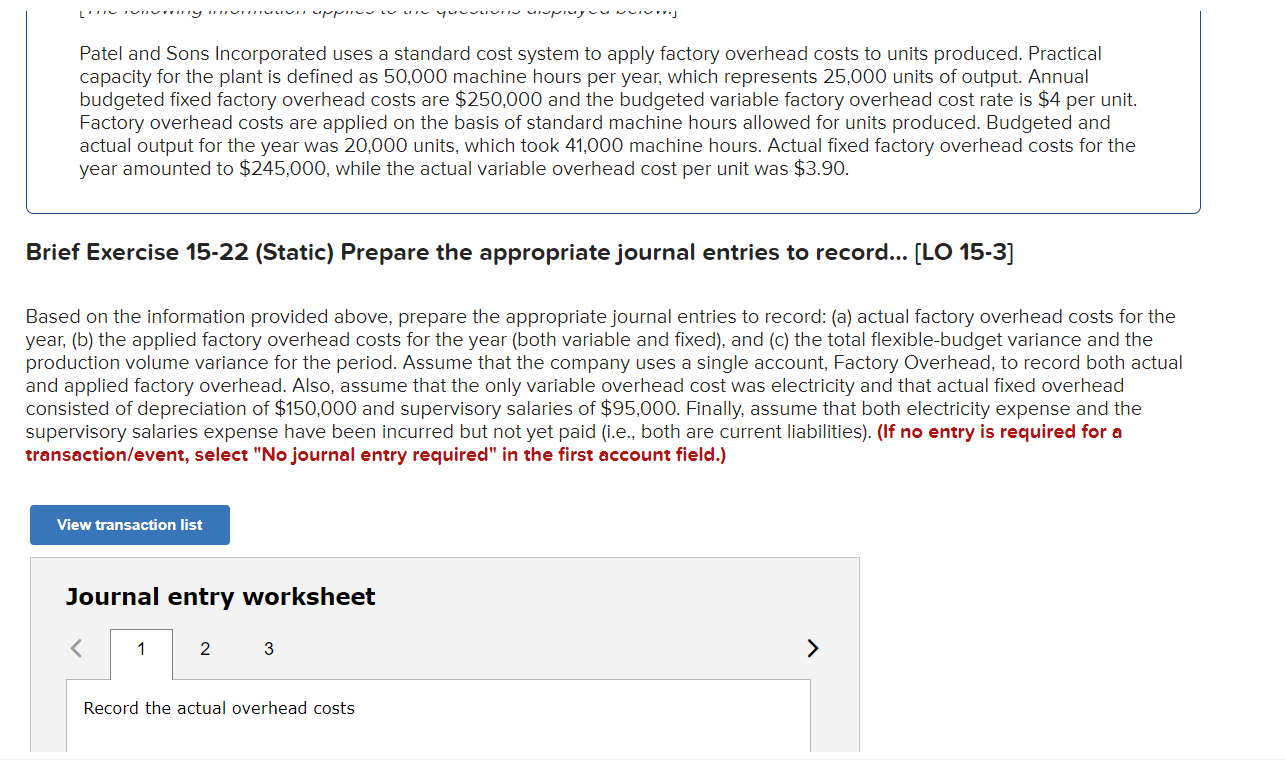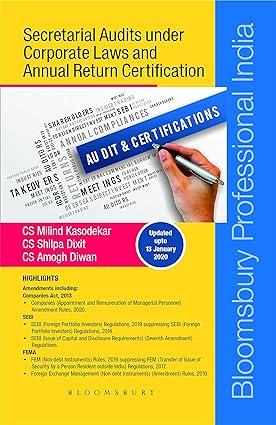

Patel and Sons Incorporated uses a standard cost system to apply factory overhead costs to units produced. Practical capacity for the plant is defined as 50,000 machine hours per year, which represents 25,000 units of output. Annual budgeted fixed factory overhead costs are $250,000 and the budgeted variable factory overhead cost rate is $4 per unit. Factory overhead costs are applied on the basis of standard machine hours allowed for units produced. Budgeted and actual output for the year was 20,000 units, which took 41,000 machine hours. Actual fixed factory overhead costs for the year amounted to $245,000, while the actual variable overhead cost per unit was $3.90. Brief Exercise 15-22 (Static) Prepare the appropriate journal entries to record... [LO 15-3] Based on the information provided above, prepare the appropriate journal entries to record: (a) actual factory overhead costs for the year, (b) the applied factory overhead costs for the year (both variable and fixed), and (c) the total flexible-budget variance and the production volume variance for the period. Assume that the company uses a single account, Factory Overhead, to record both actual and applied factory overhead. Also, assume that the only variable overhead cost was electricity and that actual fixed overhead consisted of depreciation of $150,000 and supervisory salaries of $95,000. Finally, assume that both electricity expense and the supervisory salaries expense have been incurred but not yet paid (i.e., both are current liabilities). (If no entry is required for a transaction/event, select "No journal entry required" in the first account field.) Patel and Sons Incorporated uses a standard cost system to apply factory overhead costs to units produced. Practical capacity for the plant is defined as 50,000 machine hours per year, which represents 25,000 units of output. Annual budgeted fixed factory overhead costs are $250,000 and the budgeted variable factory overhead cost rate is $4 per unit. Factory overhead costs are applied on the basis of standard machine hours allowed for units produced. Budgeted and actual output for the year was 20,000 units, which took 41,000 machine hours. Actual fixed factory overhead costs for the year amounted to $245,000, while the actual variable overhead cost per unit was $3.90. Brief Exercise 15-23 (Static) Provide an appropriate end-of-year closing entry... [LO 15-4] Based on the information provided above, provide an appropriate end-of-year closing entry for each of the following two independent situations: (a) the net factory overhead cost variance is closed entirely to Cost of Goods Sold (CSG), and (b) the net factory overhead variance is allocated among WIP Inventory, Finished Goods Inventory, and CGS using the following percentages: 10%,20%, and 70%, espectively. (If no entry is required for a transaction/event, select "No journal entry required" in the first account field.) Patel and Sons Incorporated uses a standard cost system to apply factory overhead costs to units produced. Practical capacity for the plant is defined as 50,000 machine hours per year, which represents 25,000 units of output. Annual budgeted fixed factory overhead costs are $250,000 and the budgeted variable factory overhead cost rate is $4 per unit. Factory overhead costs are applied on the basis of standard machine hours allowed for units produced. Budgeted and actual output for the year was 20,000 units, which took 41,000 machine hours. Actual fixed factory overhead costs for the year amounted to $245,000, while the actual variable overhead cost per unit was $3.90. Brief Exercise 15-22 (Static) Prepare the appropriate journal entries to record... [LO 15-3] Based on the information provided above, prepare the appropriate journal entries to record: (a) actual factory overhead costs for the year, (b) the applied factory overhead costs for the year (both variable and fixed), and (c) the total flexible-budget variance and the production volume variance for the period. Assume that the company uses a single account, Factory Overhead, to record both actual and applied factory overhead. Also, assume that the only variable overhead cost was electricity and that actual fixed overhead consisted of depreciation of $150,000 and supervisory salaries of $95,000. Finally, assume that both electricity expense and the supervisory salaries expense have been incurred but not yet paid (i.e., both are current liabilities). (If no entry is required for a transaction/event, select "No journal entry required" in the first account field.) Patel and Sons Incorporated uses a standard cost system to apply factory overhead costs to units produced. Practical capacity for the plant is defined as 50,000 machine hours per year, which represents 25,000 units of output. Annual budgeted fixed factory overhead costs are $250,000 and the budgeted variable factory overhead cost rate is $4 per unit. Factory overhead costs are applied on the basis of standard machine hours allowed for units produced. Budgeted and actual output for the year was 20,000 units, which took 41,000 machine hours. Actual fixed factory overhead costs for the year amounted to $245,000, while the actual variable overhead cost per unit was $3.90. Brief Exercise 15-23 (Static) Provide an appropriate end-of-year closing entry... [LO 15-4] Based on the information provided above, provide an appropriate end-of-year closing entry for each of the following two independent situations: (a) the net factory overhead cost variance is closed entirely to Cost of Goods Sold (CSG), and (b) the net factory overhead variance is allocated among WIP Inventory, Finished Goods Inventory, and CGS using the following percentages: 10%,20%, and 70%, espectively. (If no entry is required for a transaction/event, select "No journal entry required" in the first account field.)








